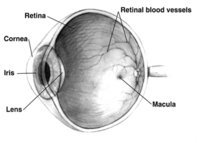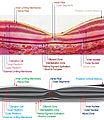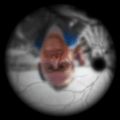Retina facts for kids
The retina is the thin layer of cells that lines the back of the eyeball in humans and in many animals. It is made mainly of neurons and its role is to sense the light which gets into the eye and send information about it to the brain.
Most information about light that leaves the retina travels through the optic nerve, and is used by the brain to recognize what you're seeing. Information about light which travels through the retino-hypothamalic tract is for adjusting circadian rhythms to the 24-hour day.
The center of the human retina, called the fovea centralis, or just fovea, has the most rod cells and cone cells for receiving light. Even though the fovea takes up only 1.5 square millimeters, it plays the most important roles in vision. It is only around 1% of the human retina, but the fovea sends about as much information to the visual cortex as the rest of the retina combined.
Images for kids
-
Fundus photograph showing the blood vessels in a normal human retina. Veins are darker and slightly wider than corresponding arteries. The optic disc is at right, and the macula lutea is near the centre.
See also
 In Spanish: Retina para niños
In Spanish: Retina para niños










